In this tutorial example, we will go through creating a service workorder and scheduling for service, entering details of the service that was performed, and printing out a report that can be used as an invoice to send to a client.
•It is highly recommended that you review this Online Help entire section on Service Workorders for complete overview , suggestions on use, tips on use and more.
The steps we will follow will be:
1. Create the new service workorder for the client
2. Schedule your tech via the workorder
3. Details of labor service provided entered into the workorder
4. Set workorder to Service Completed
5. Invoice the billable items to your customer
1. Create the new service workorder for the client
You can create a new service workorder many different ways - do review the following as they provide many time saving steps:
Create a new service workorder
Create new workorder for a client
Create via the schedule screen
In this example, we will
•select the menu option New... from the Service Workorders grid
•select the sample client Green, Frank
•click on the OK button to create the new workorder for this client

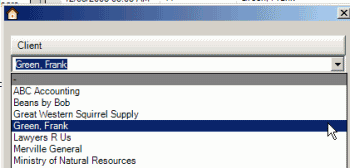
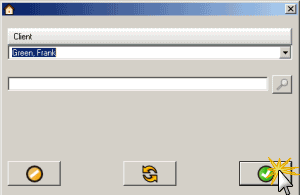
•Click on the Save menu option - note that the service workorder will automatically assign a workorder number to itself when you save.


As we won't cover all the fields and selections in the various areas of the service workorder in this tutorial, it is recommended that you do review the Service Workorder section of this Help file for information on suggested use for the fields Workorder Status, Summary, Service Notes, Priority, etc
•Service workorder header area
Feel free to enter in details and selections in the fields in the workorder for this tutorial - such as Summary of work to be performed, details in the Service Notes, Workorder Item Status so that it shows that selected statuses color on the Schedule screen etc.
2. Schedule your tech via the workorder
•Do note that you could instead have created the new workorder (step above) with the scheduled time range (steps below) via the Schedule screen as per the tutorial on creating the new workorder from the Schedule screen
•In the Schedule subsection of the workorder entry screen, use your mouse to drop down the Start Date & Time and select tomorrow's date
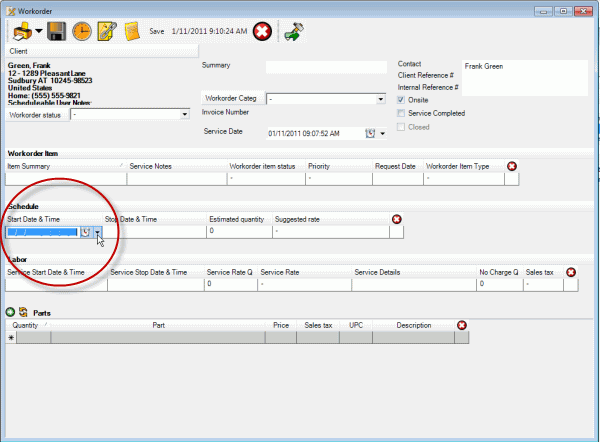
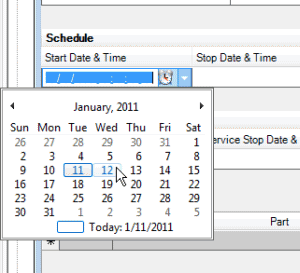
Select the Date. And than click on the Clock image to select the time.
See also the Date and Time Selection section
The time defaults to today's time if select today; or the time you have set in Global Settings for Scheduled Default Time if select a date other than today.
Whether seconds show or not depends on your computer's Regional Settings

and then tab to the next field for it to update. Refer to the section on entering time for more examples

Note how AyaNova will automatically enter in a date and time for you in the Stop Date & Time if there was nothing entered there before as a time saving feature.
You can of course edit the time as you wish.
How many minutes it enters the Stop Date & Time are dependant on what you have configured in the Global Settings - Scheduled Users / Labor Default Minutes setting
Also note that the Estimated Qty will automatically fill in for you based on the difference between the Start Date & Time, and the Stop Date & Time
•Drop down and select a rate

•Save & Exit out of this service workorder
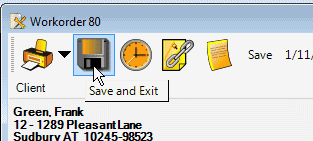
•Now view the Schedule screen selecting that date you had selected in the Schedule section of the workorder, and showing the time range, and click on Refresh ![]()
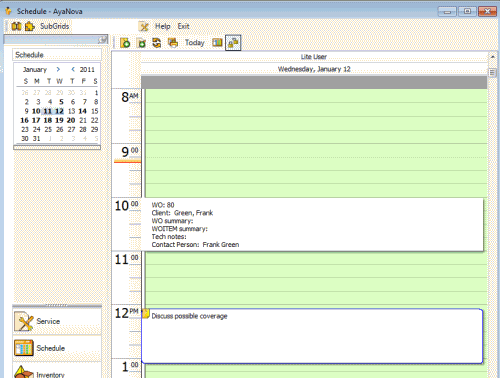
•AyaNova automatically refreshes your grids every 5 minutes, but as we just saved and we want to see this workorder item right away, click the ![]() Refresh menu option in the Schedule screen menu bar.
Refresh menu option in the Schedule screen menu bar.
•You will now see that your scheduled workorder item you just created is showing for that date and time you set it for.
See also:
Scheduled Users subsection of the order entry screen
Global Settings - Scheduled Users / Labor Default Minutes
How do I schedule a user for a new workorder item via the Schedule screen?
3. Details of labor service provided entered into the workorder
•We are going to assume for the purposes of this tutorial, that it is now the next day and the service has been performed.
•Open the workorder again by clicking on the workorder number in the Service Workorder grid (do note that you could also double-click on the scheduled workorder item in the Schedule screen)
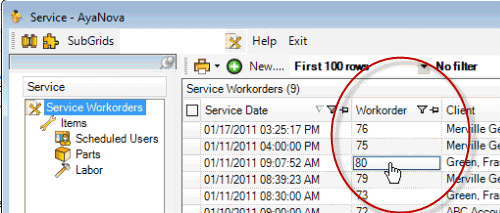
•Use your mouse to click within the Schedule subsection of the workorder entry screen - you will note when you do so that a new menu option Convert Scheduled User To Labor appears at the top

•Select this menu option ![]() Convert Scheduled User To Labor
Convert Scheduled User To Labor

•When you do so, a new Labor record is automatically created based on those settings you had for the Scheduled User record. This saves you entry time.
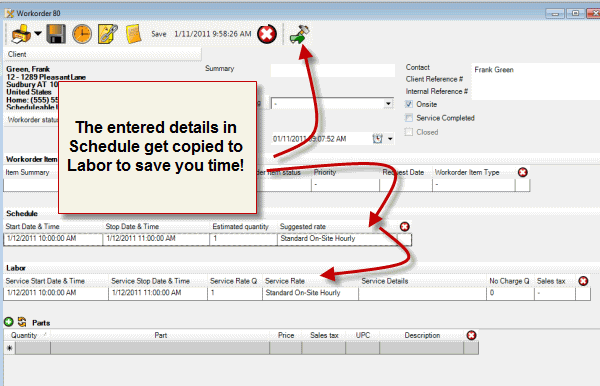
•You can of course just enter in your Labor record manually instead selecting the date and entering the time.
•In the Service Details field enter details about the service performed such as the text "specific details about the service performed so that have a history to refer to, as well as details for the client" and tab off.
See also:
Convert scheduled items to labor easily
Labor subsection of the order entry screen
Global Settings - Default Service Sales Tax
4. Set workorder to Service Completed
•For the purposes of this tutorial, we are going to assume that is all we want to enter in this workorder
•As we won't cover all the fields and selections in the various areas of the service workorder, it is recommended that you do review the Service Workorder section of this Help file
•Service workorder header area
•Check-mark the Service Completed check box

•Once set to Service Completed, then the Invoice: field is now editable. All other fields other than the Workorder Status and Closed are no longer editable as it is assumed at this point if you have completed the workorder, you will no longer edit it.
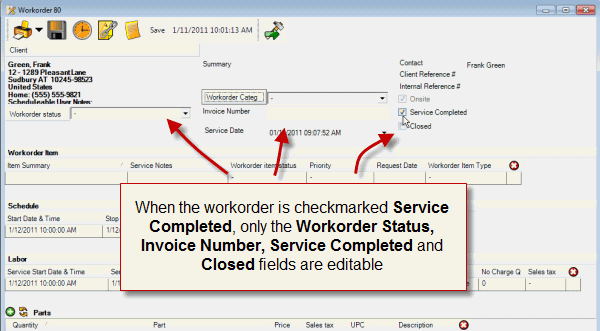
Do note that you can uncheck Service Completed so that you can edit other fields.
5. Invoice the billable items to your customer
•You will note that the only fields that are editable are Invoice Number, Workorder Status, Service is Completed, and Closed.
When a workorder is check-marked Service Completed, this sets the workorder so that it can not be accidentally edited - because you have said it is completed, and therefore should not be edited or changed. If you have to edit a field that is not one of those four stated above, you need to un-check-mark Service Completed
•At this point, you want to invoice your customer so that you get paid for the work performed.
If using the optional add-on QBI QuickBooks accounting software interface:
Use QBI to invoice out the workorders billable items, the QuickBooks invoice number is automatically entered in the Invoice Number field, and the workorder is automatically check-marked Closed (if selected to do so in QBI Preferences) and the Workorder Status set to that in your Global Settings for Workorder Closed Status. Refer to an overview of QBI features at http://www.ayanova.com/qbi.htm
If using the optional add-on PTI Peachtree accounting software interface:
Use PTI to invoice out the workorders billable items, the Peachtree invoice number is automatically entered in the Invoice Number field, and the workorder is automatically Closed (if selected to do so in PTI Preferences) and the Workorder Status set to that in your Global Settings for Workorder Closed Status. Refer to an overview of PTI features at http://www.ayanova.com/pti.htm
if not using QBI or PTI but another accounting program:
Print out for example the Sample Detailed Completed Service Workorder with Grand Total report for this workorder so that you can refer to the print out when invoicing the billable items. And include the AyaNova print out with your invoice you send to the customer so that they can see details of the work performed.
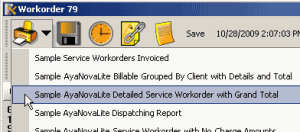
Then manually enter the invoice number from your accounting program into the Invoice Number field so that you can cross reference to the invoice in your accounting program.
![]()
When the customer pays the invoice, at that time check-mark the Closed field in AyaNova for this workorder.

If not using QBI, PTI or any other accounting program:
Print out for example the Sample Detailed Completed Service Workorder with Grand Total and send that as is to the customer for payment.
Change the Workorder Status for example to a Workorder Status called "Invoiced - waiting on payment" so that you can easily filter to see what workorders are outstanding to be paid.
And when payment is received, perhaps change the Workorder Status for example to a status called "Invoiced & Payment Received" and check-mark the Closed field to close the workorder.
•It is highly recommended that you review this Online Help entire section on Service Workorders for complete overview , suggestions on use, tips on use and more.